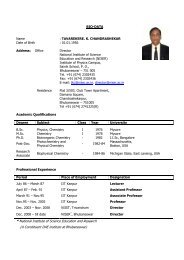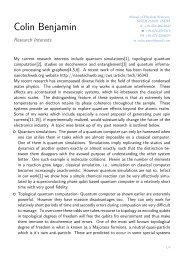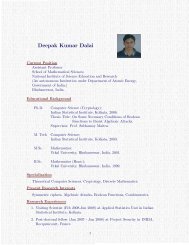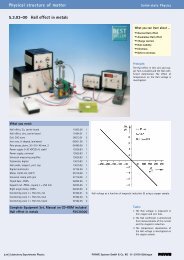Lecture-Notes (Thermodynamics) - niser
Lecture-Notes (Thermodynamics) - niser
Lecture-Notes (Thermodynamics) - niser
You also want an ePaper? Increase the reach of your titles
YUMPU automatically turns print PDFs into web optimized ePapers that Google loves.
4.9. THIRD LAW OF THERMODYNAMICS (NERNST LAW) 39<br />
2)<br />
But, for T → 0 the ideal gas is not anymore a realistic system because a real gas<br />
undergoes at low temperatures a phase transition - condensation.<br />
lim β = lim<br />
T →0 T →0<br />
3) The absolute T = 0 (zero point) is unattainable.<br />
1<br />
V<br />
<br />
∂V<br />
= 0<br />
∂T<br />
In order to show the validity of the last statement, let us analyze what happens when we<br />
are trying to reach low temperatures by subsequently performing adiabatic and isothermal<br />
transformations. If a gas is used as a working substance (Linde method), such a sequence<br />
of transformations looks in the P − V diagram as shown in Fig. 4.9.<br />
Figure 4.9: Linde method: sequence of adiabatic and isothermal transformations in a gas.<br />
Let us consider now the processes involved.<br />
A → B: isothermic compression.<br />
Work is performed on the gas and an amount of heat Q1 < 0 is given to the reservoir<br />
in a reversible process. As a result, ∆S = Q1<br />
T diminishes.<br />
B → C: adiabatic expansion.<br />
The gas performs work. Since δQ = 0, the entropy remains constant and the<br />
temperature diminishes.







